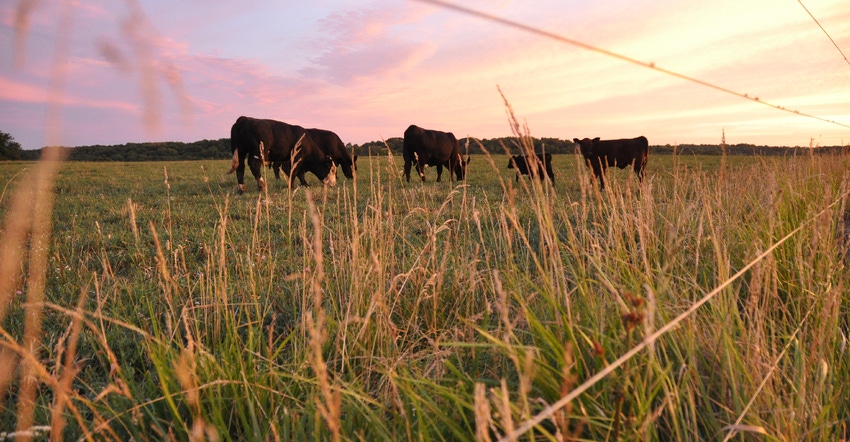
Liberty, Ill., farmer Brett Mathews says he’s nearly done putting fence back around his family’s 200-acre farm. He’s losing acreage as he pushes the fence posts behind the right of way for the state highway he lives on, Route 104. He says it’s worth it, though.
Mathews is going to rent his cropland to livestock producers to provide a natural source of nutrition to crops. That’s why he reinvested in the fence his grandfather removed 20 years ago at about $2 per foot, not counting his labor.
The regenerative farmer uses cover crops, then mows and disks the plants ahead of corn or soybeans. Since he started farming three years ago, he doesn’t use chemical fertilizer or herbicide, but he does apply manure, and he says he’s open to using Liberty on his soybeans in 2021. Mathews thinks of livestock as a key ingredient for priming soil health on operations like his that use minimal chemical inputs.
Related: How Illinois farmers are earning money on conservation
“What we’re trying to do is get more livestock out here,” he says, noting he grazes 20 sheep on paddocks that he rotates every three to four days, following them up with hogs and then pastured laying hens. He uses electric fence for the small and intensively grazed paddocks. “The sheep don’t eat the grasses. Cattle will, but I can’t afford to buy that many cattle.”
Enter the Midwest Grazing Exchange. Mathews was the first Illinoisian to open his cropland up for custom grazing on the free Midwest Grazing Exchange website when it went live in October. He’s found a livestock producer in Indiana who may take him up on his offer to graze cow-calf pairs at 75 cents a day over the winter, with rates increasing to $1.25 by early spring.
Exchange options
Illinois has just two listings on the exchange site, which is styled after state-based exchanges such as South Dakota’s and includes template contracts for farmers to modify. Users have the option to list crop residue, cover crops or pasture for grazing. Likewise, livestock producers can list their herd, how far they’re willing to travel and when they need forage.
It’s more common for livestock producers to oversee daily grazing, water and supplemental hay, paying a price per head back to the landowner. With Mathews, he’s offering to take care of those tasks on his own.
“My hope is that I’ll find a livestock producer who will take a chance on me,” Mathews says.
Meghan Filbert, co-founder of the exchange, says the service focuses on the upper Midwest region, covering Illinois, Indiana, Iowa, Minnesota, Missouri and Wisconsin. She notes farmers modify contracts to suit their situation, which varies based on water availability, location, fencing and more.
“I have a row crop farmer who’s planting cover crops and a grazier who lives nearby that wants to graze those cover crops for fall and winter forage. They split the cost of planting cover crops this year 50-50,” Filbert says. She adds that cereal rye acres are in high demand in early spring, while summer annuals planted after wheat are in high demand in August and September.
While Filbert says liability for loose animals is usually on the owner of the livestock, the owner of the grazed land will need to ensure existing fence is adequate. If it’s not, electric fence is an option. Both the livestock owner and the landowner should have liability insurance before entering into an agreement, according to the exchange’s guidelines.
“That’s the best way to go,” Mathews says. “It’s best to keep it simple and both of us have liability policies, because there’s potential for a big mess otherwise.”
Fence standards
High-tensile electric fence doesn’t exactly meet 150-year-old fence law requirements, but no one’s enforcing those requirements either. A mile of high-tensile fence can run more than $10,000, just in materials.
But farmers who raise both crops and livestock profit an average $77 per acre when grazing cover crops because of cost savings on winter feed, Filbert says.
“So many farmers we know aren’t planting cover crops, because they can’t earn a revenue from grazing them, because there’s no fence,” Filbert says. “Without livestock and fence, they can’t get cover crops to pay.”
She’d like to see USDA expand federal cost-share assistance for fences on waterways to croplands.
“We’ve been told no because it would eat so much money out of the entire cost-share system. But I truly believe if we had more nice fences, we could have more livestock integration on the land,” Filbert says.
The rotational grazing Mathews uses allows him to minimize compaction and overgrazing. This, in turn, maximizes carbon storage, which he can then test for, potentially earning income from growing carbon credit markets.
About the Author(s)
You May Also Like




